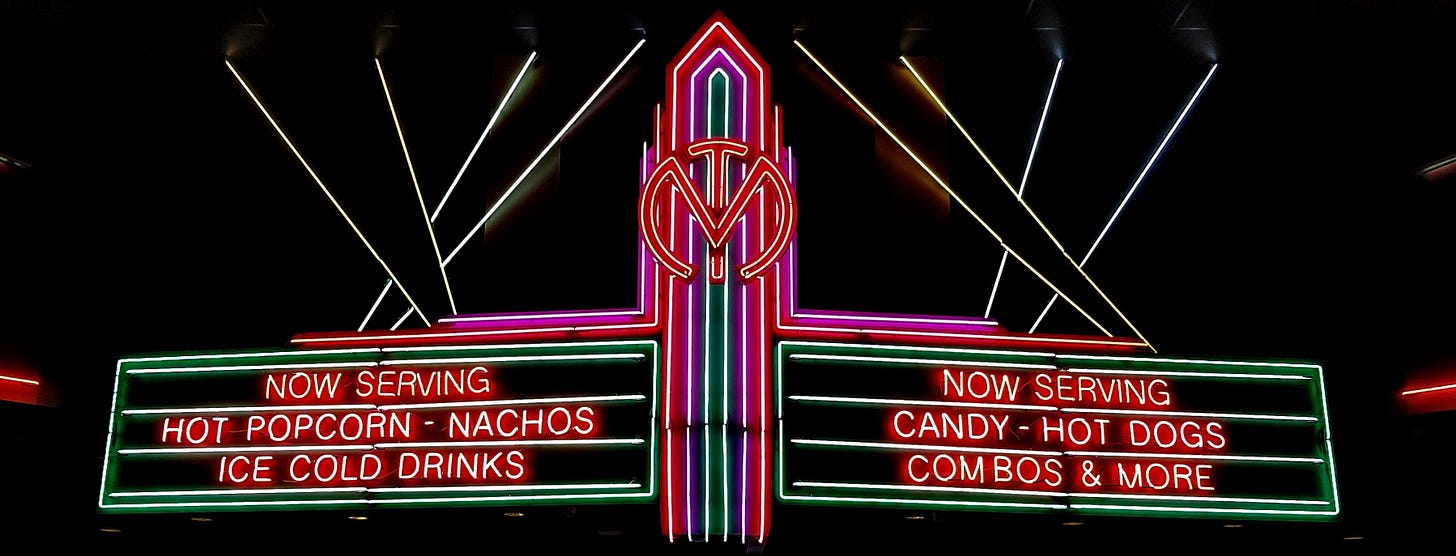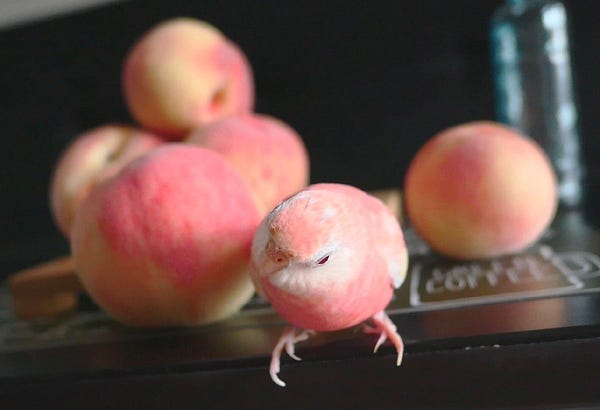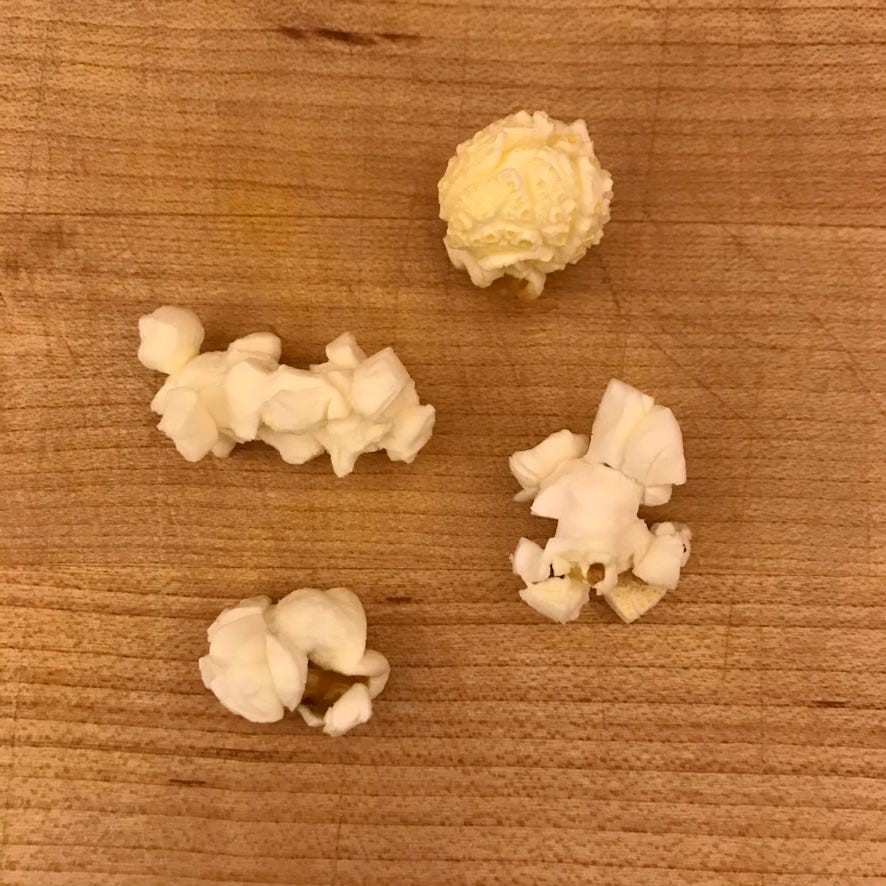What determines the shape of popcorn?
Brain, satellite, cloud, branch. Mushroom, snowflake, octopus, butterfly. A treatise on a snack.
Look, there’s not a lot of newness going on these days. Congrats on doing your best while you’re living the same day over and over.
One thing that happened this week was this great tweet, which falls into my fave category of birds in fruit camouflage:
Now that the viral sea shanty has taken its leave and gone (had to do it), I’ve moved on to another piping hot jam, this time care of a familiar face. Today I came across this video of musician Robin Hatch, who I went to elementary school with (a few years apart) once upon a time. Small world. This is a riff from one of her Zappa transcriptions she did for an audition with Dweezil Zappa last year. Click through to the thread for a few more!


And that’s the extent of what’s up! Not a lot of pep, but it’s fine. We have our jams and our comfort TV.
If you need a pep talk, here it is: It’s okay that a simple task takes you two weeks to complete. Go ahead, recycle those meal ideas from the same four dinners. Try not to worry too much about cranking the energy up to 100; if 40 is where you’re at, that’s where you’re at. If you cracked a window today, that’s basically outside! Congrats, you’re an athlete now. Also, snacks can be a meal!
It’s easy to tell how uneventful it is in my house. Most days look something like this:
Breakfast, coffee with hot chocolate powder (I like what I like). Work for an amount of time until it’s time to stop. Check in on my east coast pals (Hi GANG), maybe play a video game, then go for the daily walk. Think about dinner, cook dinner, digest dinner with a show about food (this week: 3 seasons of MasterChef Canada), second dinner around 10pm, and try to summon the desire to go to bed.
One thing that’s been a steady pleasure among the monotony is, unsurprisingly, snacks. Thanks to a wise Costco purchase from months ago, Michelle and I have been working our way through a 50-pack of microwave popcorn for a while. Since Christmas it’s geared up even more, now that we’ve got a new microwave with a functioning plate thingy that’s big enough to keep spinning when the bag expands. What can I say, we’re in the big time now.
Popcorn is one of the more perfect foods. It’s salty and has great crispness like a potato chip, but it’s less oily overall and doesn’t shard or crumble. It melts in your mouth, it’s warm, and it’s not filling.
Perfect, I say!
And since popcorn has been a regular occurrence around the house, I’ve found myself preferring different shapes over others. With the difference in texture and mouthfeel, varying risk levels of the hidden kernel, and the prevalence of wild gum-harming husks, it’s only natural that the brain uses its marvellous powers of observation and deduction to seek out the most ideal specimen to mönch.
Or maybe because there’s not much else to think about. I guess we’ll never know!
Out of all of my meditations on this snack, I developed a system of identifying the different “pops” and began to wonder how and why the same patterns kept popping up, bowl after bowl.
Let’s run these bad boys down.
Brain: You often see this pop at the gourmet popcorn joint (or maybe just the Kernels kiosk at the mall), but less in home-pop situations. This one’s great for adding seasoning because the fine ridges and bumpy texture on top of a fairly uniform shape all make for even spice distribution and a consistent product. The husk is also minimal. Great for business, I suppose, but this is where it goes downhill. Mouthfeel-wise, brains are less ideal. There’s so much air in the centre that the texture is almost too springy, like delicious but ultimately disappointing styrofoam. The brains are missing a little crunch for me.
Satellite: A common stovetop pop shape that has enough larger grooves and corners to hold larger toppings like sesame seeds or crumbled seaweed. Wide, flat arms jut out from all sides to offer the quintessential popcorn experience. Its crisp bite and irregular shape feels great in the mouth and it holds salt really well. Plus, the husk tends to be fairly broken down so there’s not too much risk of finding a rogue kernel inside and fearing for your fillings. Satellites are the drone bees of the popcorn colony: plentiful, dutiful, and the hive wouldn’t be the same without them.
Cloud: Oh, the cloud. I waffled on what I truly wanted to name this one. Octopus, mushroom, blanket over a rock…there were a few contenders, but some people (you know who you are) actually don’t think this pop is an Edible Arrangement directly from hell, so I will check my biases at the door. The cloud it shall be, officially, but this is my publication and I answer to no one. From a spiritual perspective, blanket on a rock is absolutely it. Looks floofy-comfy-cozy and inviting on the outside, but a cruel disappointment waits just below the surface. The cloud is a monster, the result of asking too much of an under-powered microwave. These morsels were betrayed by the process and left to pop only partially. This leaves a nugget of gravel ready to be discovered under a mere whisper of popcorn pillow. 1/10 for mouthfeel. A thorough disappointment.
Yes, I’m writing this late at night, how…did…you...know.
Branch: Call me regional branch manager because these pops are pretty close to perfect and I’ll work to find them in the bowl. Similar in construction to the satellite with knobbly bits and a satisfying texture, branches reach out further from their centre than their more compact counterparts. This makes them more likely to lose a few of their farthest extremities in the tumble from the bag or the pot to the bowl. As much of a drawback as it might seem, the branch leaves behind small and perfectly soft popcorn boules that wait for you at the bottom of the bowl until the very end. Branches care about you like that - they don’t leave kernels behind, only the good stuff. 8/10 for mouthfeel, low to medium risk of a kernel, husks typically shed but don’t let your guard down.

The professional popcorn purveyors of the world have come to a similar conclusion; there are many different varieties of corn, but only a few distinct shapes when the kernels pop.
BUT WHY?
According to Popcorn Australia, there are two main shapes, the mushroom (brain) and the butterfly (satellite). What makes the difference between them is a confluence of the kernel’s structure and the character of the heat that’s applied. The kernel’s hull weakens and softens with heat, which causes small holes to appear. That’s where the pressure builds and the conditions become right for the kernel to burst.
If the kernel is heated from roughly all sides, the inner sugars and starches break through the hull evenly and form the mushroom/brain shape.
In both types, […] it’s that popping pressure that causes a failure in the outer skin of the kernel. Even though the kernel skin is quite tough, the hole expands with the heat and the skin stays mostly together. The starches within the kernel are blown out through the hole, which causes the popcorn to invert, so that the skin is now on the inside, and then as it cools it cracks in several places.
When the expansion occurs evenly, you get a mushroom shape popcorn, which is roughly spherical, with the outer surface developing fissures to resemble a mushroom.
Some varieties of corn don’t expand in an even fashion. The corn kernels actually have several lobes. When these lobes expand, they expand away from each other, which results in a butterfly shaped popcorn.
It makes sense that the more “gourmet” popcorn ends up being the brain/mushroom shape because there’s likely more uniform heat applied to the kernels in industrial poppers than the uneven microwave or stovetop options. The more localized the heat is, the more likely the starches will be forced out of that single port. And that’s what makes the more irregular branch and satellite shapes.
As I suspected, the cloud shapes result from low heat and an incomplete pop. The hull doesn’t fully break down and remains crunchy, while the starch doesn’t pop with enough velocity to create a larger and lighter structure.
So when you’re left with salty pebbles at the bottom of the bag, blame the heat. This also explains the vigourous shaking required for stovetop popping - it’s for even heat distribution on the raw kernels, not necessarily to prevent popped kernels from burning since they rise to the top anyway!

I could wrap up here, but there are a few other corniosities to talk about. Writing the caption above reminded me of movie theatre popcorn (so salty, so buttery, so yellow) and I wondered if the colour was the result of seasoning or if there was a special movie theatre/commercial variety out there.
A quick Google told me there are two major types of corn used for popcorn: white and yellow. So the colour originates from the kernels used rather than exclusively coming from what’s added to the mix. In hindsight, this is so obvious given the natural colour variety in corn. Common monoculture strategies tend to opt for the selectively-bred yellow or white corn (hence the yellow or white varieties of popcorn), rather than the more diverse colour and flavour ranges of red, purple, and other heirloom varieties.
Based on the information from the esteemed cornpopper.ca, you can still find some of the less common types of corn to heat until they explode. Varieties like Sweet Baby Blue, Midnight Blue, Lady Finger, Purple, and Vintage Red have more complex flavours while being smaller in size. Think sweeter (the deeper the hue, the sweeter they’ll be) or nuttier (often found in red and yellow varieties).
I was disappointed to learn that the final product does not carry the same colour as the kernel it’s popped from. Sorry to break it to ya.
Now we know some stuff about popcorn! Go forth and enjoy your snacking with a little extra info under your belt.







